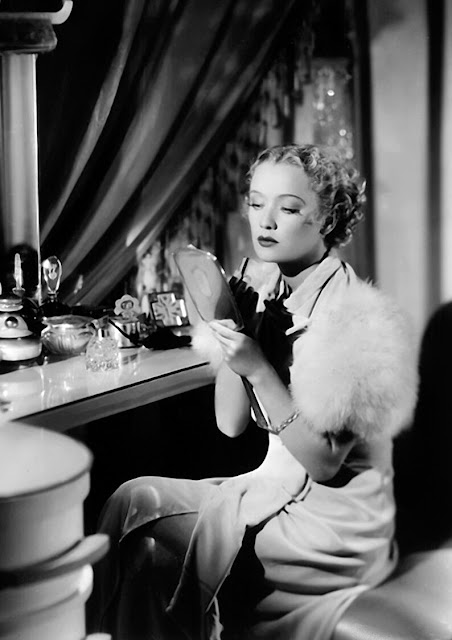I’m amused when I’m sent things that purport to
analyze and explain my plays, and they are almost always centered on theatrical
antecedents. It is assumed, by a number of smart people, that Brecht was my
primary influence in the writing of Menagerie.
I was more influenced by Clarence Brown than by Brecht, but this type of
analysis gives people something to do. I think this scholarly research is a
variant on my mother, my sister, and me revising movies in the house and the
backyard. I told this to Gore [Vidal] and he said “Yes, but you and your mother
were only disturbing the squirrels, some nosy neighbors, and your psyche.
Academics disturb everything.”
Do you agree?
I don’t think about it.
 |
| Miriam Hopkins |
What are some of
the films that influenced Menagerie?
Well, Amanda is certainly a repository of mannerisms and methods
belonging to my mother—Edwina—but I was thinking of a number of
women—actresses—when I cobbled her together. There is a great deal of Miriam
Hopkins in Amanda, and it troubles me that so many people are no longer aware
of her. If they know her at all, it is as the butt of many jokes made at her
expense by Bette Davis and her fans,
but Miriam was a remarkable actress and a great character, wild and funny and
smart. She was very Southern, in that she was determined to always be pretty
and useful and funny and necessary. I
knew a lot of women who were like Miriam Hopkins or wanted very much to be Miriam Hopkins when I was growing up.
She burned brightly and quickly; she was afraid she might miss things, so she
flitted about. I spent a number of years obsessed
with Miriam Hopkins. I carried her in my heart and in my memory. I would see
her on streets and imagine her in particular situations. She occupied, for
brief moments of time, the forms of Blanche and Amanda and then became what
became Lady Torrance. I loved her. Difficult? I guess so. Not with me. She was
every Southern divinity you could imagine. Smart and funny and elegant, and I
kept looking for her in Joanne [Woodward], and Carrie Nye and Diane Ladd, but
there was no one like her. No one. I will hear nothing bad of Miriam Hopkins.
So Miriam got caught up in the recipe that is Amanda. I was also thinking of a
particular quickness—a changing of the masks—that one saw in the work of Ruth
Chatterton. Chatterton could very quickly alter her face to convey a series of
emotions, and you could chart the survival of the women she was playing. It was
like a shuffling of psychic cards across her face. Wonderful, wonderful
actress. When she began to work in talking pictures, she was able to do the
same thing with her voice—shifting, altering, hiding, flaunting. I needed some
of that for Amanda, particularly when she is speaking to anyone outside of the
hive she shares with Tom and Laura. There’s Fay Bainter in Amanda—and Fay
toured quite successfully in Menagerie, perhaps unknowingly stepping
into some of her own skin. But I took these various women and I placed them on
a solid foundation from which they could operate, and that was Ida Lupino in a
film called The Hard Way, which bears very little resemblance to Menagerie,
but Lupino plays a scrappy, tough, manipulative woman who will do anything to
get her kid sister into better situations—and to find for herself an identity
and an annuity. I remember the grimy town and the grimy home in which the
characters lived, and I began to imagine the oilcloth and soiled damask of the
tenement in St. Louis in which Amanda would navigate and dream and plan and
pine. So it was The Hard Way that I slipped beneath these women—a plate
upon which to serve them up, so to speak.
 |
| Ruth Chatterton |
 |
| Fay Bainter |
 |
| Ida Lupino in The Hard Way (1943) |
Comments
Post a Comment
Thank you for your comments. The moderators will try to respond to you within 24 hours.